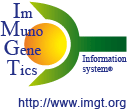IMGT functionality
The IMGT 'functionality' concept is part of the 'IDENTIFICATION' axiom of IMGT-ONTOLOGY [1] [2] [3] [4].
IG and TR
The identification of the functionality of an IG or TR entity is based, for rearranged entities on the sequence analysis of the entity (productive or unproductive), and for germline or undefined entities on the sequence analysis of the corresponding gene unit (functional (F), Open Reading Frame (ORF) or pseudogene (P)) [4].IG and TR rearranged entities
A rearranged IG or TR (genomic or cDNA) entity is productive or unproductive.
- PRODUCTIVE
-
A rearranged IG or TR (genomic or cDNA) entity is productive if the
coding region has an open reading frame, with no stop codon and no
defect described in the initiation codon, splicing sites and/or
regulatory elements, and an in-frame JUNCTION.
productive (IMGT keyword)
Identifies, whatever the molecule type, the functionality of entity sequences in rearranged or partially rearranged configuration, whose coding region has an open reading frame without stop codon and without described defects in the initiation codon, splicing sites and/or regulatory elements. Furthermore, for IG and TR, there is an in-frame junction. - UNPRODUCTIVE
-
An unproductive rearranged IG or TR (genomic or cDNA) entity is
characterized by an out-of-frame JUNCTION and/or the presence of stop
codon(s) and/or frameshift mutation(s), and/or a defect described in
the splicing sites and/or the regulatory element(s), and/or unusual
features (TRANSLOCATED, GENE FUSION...) and/or changes of conserved
amino acids demonstrated as leading to uncorrect folding.
unproductive (IMGT keyword)
Identifies, whatever the molecule type, the functionality of entity sequences in rearranged or partially rearranged configuration, whose coding region has stop codon(s) and/or frameshift mutation(s), and/or if a mutation affects the initiation codon, and/or if there are defects in the splicing sites and/or in the regulatory element(s), and/or there are unusual features (translocated, gene fusion...) and/or changes of conserved amino acids demonstrated as leading to incorrect folding. Furthermore, for IG and TR an out-of-frame junction.
IG and TR germline and undefined entities
A germline (V-GENE, D-GENE or J-GENE) or an
undefined C-GENE
IG or TR entity is functional (F), Open Reading Frame (ORF) or
pseudogene (P).
The functionality is defined by the sequence analysis of the
gene unit (L-V-GENE-UNIT,
D-GENE-UNIT,
J-GENE-UNIT
or C-GENE-UNIT).
| IDENTIFICATION (IMGT keywords) |
DESCRIPTION (IMGT labels) |
||||
|---|---|---|---|---|---|
| Entity type | Configuration type | Molecule type | Functionality | Entity prototype | Gene unit |
| V-gene | germline | gDNA | F, ORF, P | V-GENE | L-V-GENE-UNIT |
| D-gene | germline | gDNA | F, ORF, P | D-GENE | D-GENE-UNIT |
| J-gene | germline | gDNA | F, ORF, P | J-GENE | J-GENE-UNIT |
| C-gene | undefined | gDNA | F, ORF, P | C-GENE | C-GENE-UNIT |
- FUNCTIONAL
-
A germline entity (V-GENE, D-GENE or J-GENE) or a C-GENE is
functional (F) if the coding region of the respective corresponding gene
unit (L-V-GENE-UNIT, D-GENE-UNIT, J-GENE-UNIT or C-GENE-UNIT) has an
open reading frame without stop codon, and if there is no described
defect in the splicing sites, recombination signals and/or regulatory
elements.
functional (IMGT keyword)
Identifies, whatever the molecule type, the functionality of entity sequences in undefined or germline configuration, whose coding region has an open reading frame without stop codon, no defect in the splicing sites, recombination signals and/or regulatory elements.
FUNCTIONAL (IMGT annotation rules)Germline V and J genes and alleles with a STOP-CODON region end
The IMGT functionality of germline V and J genes and alleles which have as unique defect an in-frame STOP-CODON at their region end (3' last codon for V-REGION, 5' first codon for J-REGION based on IMGT [3]) is functional.
Indeed, this STOP-CODON may very frequently disappear during V-(D)-J rearrangements owing to the mechanisms of junctional and/or N-diversity. The resulting rearranged sequences are classically either productive or unproductive. - ORF (Open Reading Frame)
-
A germline entity (V-GENE, D-GENE or J-GENE) or a C-GENE is qualified
as ORF (Open Reading Frame) if the coding region of the respective
corresponding gene unit (L-V-GENE-UNIT, D-GENE-UNIT, J-GENE-UNIT or
C-GENE-UNIT) has an open reading frame, but:
- alterations have been described in the splicing sites, recombination signals and/or regulatory elements.
- and/or changes of conserved amino acids have been suggested by the authors to lead to uncorrect folding.
- and/or the entity is an orphon.
ORF (IMGT keyword)
Identifies, whatever the molecule type, the functionality of entity sequences in undefined or germline configuration, whose coding region has an open reading frame (ORF), but alterations have been described in the splicing sites, recombination signals and/or regulatory elements, and/or changes of conserved amino acids to lead to incorrect folding, and/or the entity is an orphon.
ORF (IMGT annotation rules)
A gene unit is ORF if:- one of the following labels is noncanonical: DONOR-SPLICE, ACCEPTOR-SPLICE, X-HEPTAMER and/or X-NONAMER.
- and/or conserved motifs are mutated: J-MOTIF, 1st-CYS, CONSERVED-TRP and/or 2nd-CYS.
- and/or there is a deletion of more than 3 AA in a FR-IMGT or a CDR-IMGT.
- and/or the length of V-INTRON or X-SPACER is unexpected (difference of 3 nt for X-SPACER and V-INTRON > 500 nt).
- PSEUDOGENE
-
A germline entity (V-GENE, D-GENE or J-GENE) or a C-GENE is qualified
as pseudogene if the coding region of the respective corresponding
gene unit (L-V-GENE-UNIT, D-GENE-UNIT, J-GENE-UNIT or C-GENE-UNIT)
has stop codon(s) and/or frameshift mutation(s).
In particular, a L-V-GENE-UNIT is considered as pseudogene if these defects occur in the L-PART1 and/or V-EXON, or if there is a mutation in the L-PART1 INIT-CODON atg.
A J-GENE-UNIT is considered as pseudogene if it has been identified by the presence of a recombination signal upstream of an open reading frame, but it has no donor splicing site in 5' or the donor splice is not in the expected sf1 or if no J-MOTIF is identified.
Pseudogene (IMGT keyword)
Identifies, whatever the molecule type, the functionality of entity sequences in undefined or germline configuration, whose coding region has stop codon(s) and/or frameshift mutation(s), and/or a mutation affects the initiation codon.
Pseudogene (IMGT annotation rules)
A gene unit is pseudogene (P) if:- there is a STOP-CODON in the coding region (except the last codon of the V-REGION and the first codon of the J-REGION).
- and/or there is an insertion or a deletion non-multiple of 3 that causes a frameshift.
- and/or the splicing between DONOR-SPLICE and ACCEPTOR-SPLICE forms a STOP-CODON.
- and/or one of the following labels is missing: INIT-CODON, L-PART1, L-PART2, DONOR-SPLICE, ACCEPTOR-SPLICE, X-HEPTAMER and/or X-NONAMER.
- and/or a part of the V-REGION is missing (too much mutated to be described).
Gene or allele functionality shown between parentheses or brackets
Gene or allele functionality is shown between parentheses, (F) or (P),
when the accession number refers to rearranged genomic DNA or cDNA and
the corresponding germline gene has not yet been isolated.
Gene
or allele functionality is shown between brackets, [F] or [P], when
the accession number refers to genomic DNA, but not known as being
germline or rearranged.
Partial gene unit sequences
Functionality is assigned taking into account, whenever possible, the
data from other sequences of the same gene.
A partial sequence
with an open reading frame will be considered as ORF, and not
functional, except if clearly mentioned by the authors.
Genes other than IG or TR
For genes other than IG or TR (L-GENE or GENE), the functionality instances are the same as for the IG and TR germline or undefined entities, and base on the sequence of the gene units (L-GENE-UNIT, GENE-UNIT), that is FUNCTIONAL, ORF and PSEUDOGENE.
| IDENTIFICATION (IMGT keywords) |
DESCRIPTION (IMGT labels) |
||||
|---|---|---|---|---|---|
| Entity type | Configuration type | Molecule type | Functionality | Entity prototype | Gene unit |
| L-conventional-gene | undefined |
gDNA | F, ORF, P | L-GENE | L-GENE-UNIT |
| conventional-gene |
undefined | gDNA | F, ORF, P | GENE | GENE-UNIT |
| [1] | Lefranc, M.-P. IMGT Locus on Focus : a new
section of Experimental and Clinical Immunogenetics. Exp. Clin.
Immunogenet., 15, 1-7 (1998) PMID:9619395,
LIGM:199 |
| [2] | Giudicelli, V. and Lefranc, M.-P. Ontology for
Immunogenetics: IMGT-ONTOLOGY. Bioinformatics, 15, 1047-1054 (1999)
PMID:10745995,
LIGM:221 |
| [3] | Giudicelli, V. and Lefranc, M.-P., IMGT-ONTOLOGY 2012. Front Genet. 3:79 (2012). doi:10.3389/fgene.2012.00079. Epub 2012 May 23 Online access PMID:22654892, LIGM: 401 |
| [4] | Lefranc M-P. Immunoglobulin (IG) and T cell receptor genes (TR): IMGT® and the birth and rise of immunoinformatics. Front Immunol. Feb 05;5:22 (2014). doi:10.3389/fimmu.2014.00022. Open access PMID: 24600447, LIGM: 429 |



